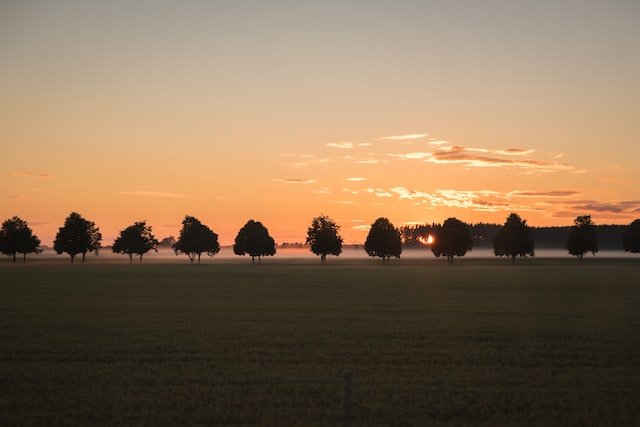We often hear the word ‘lines’ in photography. To define a line in geometric parlance, we can define it as a unidimensional object between two points. Lines can also exist in three-dimensional space but are still unidimensional and extend infinitely in either direction. But that’s the scholarly definition of the line, which has very little significance in photography.
In photography, a line can be curved or straight, or even zigzag, marked as the outline of a subject, or even superficial, working as a connecting line between two compositional elements. Again it can have a deeper connection, too, such as when it serves as a guiding line to the main object of focus in composition. So lines serve a range of purposes in photography.
Lines along and shaped assume a fundamental aspect of composition in photography. Without a mastery of lines, you will not find the same success you’re looking for in specific genres of photography. Street photography, e.g., is one genre where lines routinely come back as a compositional element. An example I can cite is the works of Alexander Schoenberg. A German photographer who came into the world of photography quite accidentally followed his doctor’s advice to “just more walking.”
Alexander’s work is an exquisite example of how lines can be used in multivarious manners to express the photographer’s viewpoint. It’s not always necessary that a photographer must incorporate a straight line in a composition. Even a curved line or a hint of a line has the desired effect.
Different Types of Lines in Photography
Lines are used in several different manners in photography, each conveying a different mood and meaning to the whole image. Lines are geometric shapes but powerful compositional tools in the right hands. Straight lines, for example, convey a message of stability, peace, and solidity.
A curved line is often used to convey a sense of direction, guiding the viewer’s eyes to the focus of the image (and often the image’s main subject). Let’s take a detailed look at the use of lines in a photographic composition. While we are at it we shall also look at interesting ways to use lines to create a strong impact in photography.
The Leading Line
Perhaps the most often used term is when we refer to lines in photography. The leading line is a line that can be both straight and curved, and it generally points the viewer’s eye toward the focus of the image. The leading line is a guiding line. The purpose of that line is to guide the viewer through the clutter of composition and toward the main subject. The positioning of the line is mainly in the foreground because the purpose of the line is to draw the user deeper into the photo.
Looking at some of the photos from Alexander Schoenberg’s Urban Melancholy series I and II, you can find some beautiful examples of leading lines. Most of his photographs are in monochrome, which is why the strength of his compositions comes through in those photos. But what stands out is the use of leading lines in his composition that draw his viewers into his composition.
One of the classic examples of leading lines in photography is Henri Cartier-Bresson’s image of a cyclist going past a flight of stairs along a narrow alley. Apart from being a perfect example of the principle of “Decisive Moment,” the photo is also a powerful example of how leading lines can be used in a composition.
The flight of stairs curling down and leading toward the cyclist and the curved curb seemingly pointing toward the cyclist are good examples of leading lines. It has to be mentioned that leading lines don’t always have to be straight. They can be curved, diagonal, or meandering. As long as they serve the primary purpose of drawing the user’s attention toward the subject, they would be referred to as leading lines.
Horizontal Lines
The most common placed used horizontal lines are in landscape photography. The horizon line is a common horizontal line that everybody can see in a landscape photo. There is no trick in it. This is a common way of using a horizontal line in your composition. However, there are other methods of using horizontal lines in your composition. You can use multiple horizontal lines that divide a photo into segments.
This is a great way to create a sense of depth in your photos. Let’s say there is a valley that culminates into a mountain range. You incorporate a human touch in the photo in the form of a person standing in front of a fence running horizontally in the photo. So, there are two horizontal lines in the same frame. The first one is where the foreground and middle ground meet. The second one is where the middle ground and the background meet.
You can incorporate a horizontal line in many other ways. For example, you can use a bench in a park, a curb running horizontally across the frame, a roofline, a ledge, a terrace, or anything practically that is a straight line and runs across the frame horizontally.
Vertical Lines
Vertical lines are not as commonplace in photography as horizontal lines are. But they’re not rare, either. The perceived strength of a vertical line comes from the sense of boldness and power that emanates from a structure that stands upright amidst other elements.
The thing about vertical lines is that they look a bit secluded and lonely in a composition if left to all by themselves. A skyscraper, for example, a lonely tree, or even a cell tower in the middle of nowhere. They all look lonely, desolate, and secluded. But you can use them in your compositions if you know exactly what you’re attempting to do. For example, when shooting a minimalist composition, you can include a lone tree in a field, a cell tower, or a skyscraper and leave the rest of the frame empty to include negative space.
Vertical lines can be used to create what is known as artificial framing. Such as when you shoot through two trees and use them as an artificial frame to highlight the subject.
You may enjoy reading What are the Different Parts of a DSLR Camera?
Rule of Thirds Definition and Use
The rule of thirds is a compositional rule that’s commonplaced in photography. In brief, the rule of thirds states that if you divide a frame by passing two sets of parallel lines, one running horizontally and the other running vertically, in a way so that it intersects at four points on the frame and forms nine equal squares, much like Tic Tac Toe.
Now the rule of thirds states that if you place a subject on one of the four intersecting points, the overall quality of the image would be much better than if you place the subject on any other point in the frame. As a matter of fact the viewer’s attention falls on the focal point of your composition much more easily when you place them on the intersection points rather than on the middle of the frame.
The fundamental aspect of the rule of thirds is based on both horizontal and vertical lines. Without these lines, working with the rule of thirds would be impossible.
The rule of thumb when using the Rule of thirds is to make a quick and rough estimate of the center part of the frame and then place the point of interest off the center of the frame. These days digital cameras come with a rule of thirds grid. Just place the subject on one of the intersection points.
 Diagonal Lines
Diagonal Lines
Diagonal lines, as the name suggests, have a specific orientation, bringing an element of tension to the images. Why? Because of the reasons we learned in the previous paragraphs, anything that’s not perfectly flat or horizontal or vertical and, therefore, perfectly balanced evokes a sense of tension in the photo. A see-saw hanging diagonally in the air implies it’s bound to go down either way. In other words, it’s not at rest.
But there are perfectly good examples of diagonal lines used for something else in a photographic composition other than infusing tension. Diagonal lines are used to form leading lines. In a street photography shot, diagonal lines are formed when you infer the lines of buildings along the street. The height of the buildings forms an imaginary line along the composition. If a subject is deeper in the composition and the diagonal lines point at that subject, then the lines are leading. Great examples of these are in the photos of Gary Winograd. One of the pioneers of street photography.
Diagonal lines don’t always have to be actual lines. You can even use the direction that a human eye is looking at to create an imaginary diagonal line in an effective way. That means you can use even the concept of line rather than an actual line.
You may enjoy reading What is Street Art Photography?
Golden Triangle and the Use of Diagonal Lines
One of the uses of diagonals is in creating Golden Triangles. The Golden Triangle is an image composition technique in photography and is very much like the other rules of composition, such as the rule of thirds. In a rule of thirds, we use horizontal and vertical lines. In a Golden Triangle, we use diagonal lines.
There are many ways to overlay a Golden Triangle and use that to improve the compositional quality of your photographs. Let’s introduce the concept first.
A simple way to incorporate the Golden Triangle in your photography composition is to draw a diagonal line connecting one pair of opposite vertices in the frame. Once this is done, draw two lines from the other pair of opposite vertices and connect them to the diagonal line at a right angle. Once you do that, there will be two sets of congruent triangles in the frame.
The Golden Triangle rule states that if you place your important elements in the composition along the grid lines that you just created, the aesthetics of your image will be much better than if you had created a normal composition. You can change things by drawing a diagonal line along the opposite vertices. Also, you can flip the frame, compose in portrait mode rather than landscape mode, and still use the same concept for aligning the subject in your photos.
Both the Golden Triangle and the Rule of thirds are used in different branches of visual arts beyond photography.
Converging Lines
You might have seen an image of a road or railway track stretching out into the horizon, seemingly meeting at infinity. This is a classic example of converging lines. Converging lines are always created by parallel lines that appear to converge at a distance but don’t converge.
Converging lines can be used to produce depth and dimension in your photos. They can much more easily be used as leading lines leading into the frame and onto something in the background. The above example of a road leading towards the horizon or a mountain range is good.
The impact of converging lines is that they lead the viewer into a shot and let their eyes wander around until they find something interesting in the background. Not all compositions, though, follow the same rule. Sometimes you may come across compositions where a road may lead to nowhere and appear to converge at a distance. Such as a mountain road that stretches towards the horizon. In such compositions, the viewer is free to conclude the composition. But it can quickly become boring. So ideally, the best way to use converging lines is by using something in the frame that the lines can lead to. In the same way, curved lines serve their purpose.
Curved Lines
The beauty of curved lines is that they appear softer and more subtle in the scheme of things. Unlike horizontal or vertical lines, curved lines ease a user into a composition. The beauty of a curved line is that when they take the viewer into the shot and as the viewer gets deeper into the shot, the whole frame becomes familiar to them. So it’s like a guiding line. Curved lines can serve as a leading line but don’t think that they always do
Where can you find curved lines in a photographic composition? Examples of curved lines are a river or a gorge that meanders and moves deeper into the composition. Rivers naturally form what is known as an S Curve in photography. The best way to ensure that a curved line serves the purpose of its presence is by leaving something in the frame that the curved line can lead to. If it leads to emptiness, it becomes boring for the user, and the composition does not mean anything.
You may enjoy reading What is High Resolution in Photography?
Techniques for utilizing lines in photography
Composition
Understanding how lines interact within the frame is essential for creating compelling compositions. Photographers can use lines to create balance, symmetry, or tension within the image, depending on the desired effect.
Perspective
Changing the perspective can alter the way lines appear in a photograph, leading to different interpretations and visual experiences. Experimenting with angles and viewpoints can help photographers find unique ways to incorporate lines into their compositions.
Lighting
Lighting plays a crucial role in accentuating lines within a photograph. Shadows and highlights can enhance the visibility and texture of lines, adding depth and dimension to the image.
Examples of lines in famous photographs
Many iconic photographs throughout history have effectively utilized lines to create powerful and evocative images. From Ansel Adams’ majestic landscapes to Henri Cartier-Bresson’s decisive moments, lines have played a pivotal role in shaping the visual language of photography.
FAQs
1. How do lines enhance the composition of a photograph?
Lines can be used to lead the viewer’s eye, frame the subject, and convey mood and emotion, ultimately enhancing the overall composition of the photograph.
2. What are leading lines, and how are they used in photography?
Leading lines are lines within a photograph that guide the viewer’s gaze towards a specific focal point or subject, creating a sense of depth and dimension in the image.
3. How can photographers experiment with different types of lines in their compositions?
Photographers can experiment with horizontal, vertical, diagonal, and curved lines to create varying visual effects and evoke different emotions in their audience.
4. Why is lighting important in accentuating lines in photography?
Lighting plays a crucial role in highlighting the texture and visibility of lines within a photograph, adding depth and dimension to the image.
5. Can you provide examples of famous photographs that effectively use lines?
Iconic photographs by renowned photographers such as Ansel Adams and Henri Cartier-Bresson demonstrate the powerful use of lines in creating visually compelling images that resonate with viewers.
Conclusion
Lines are a fundamental element of photography, serving as powerful tools for composition, expression, and storytelling. By understanding the different types of lines and how to use them effectively, photographers can elevate their images and create compelling visual narratives that resonate with viewers.
Considering a new camera for 2023? take our independent quiz to help understand the best camera for you. Which Camera should I buy in 2023? – Take Our Camera Quiz – Photography Revision







Comments are closed.